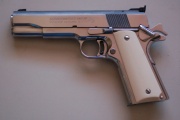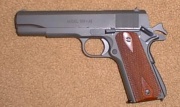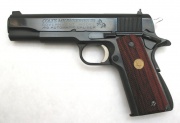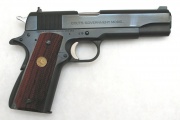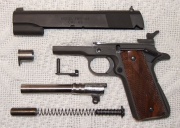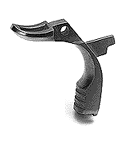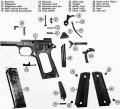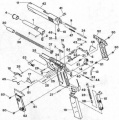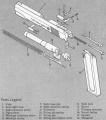M1911 Colt pistol
| United States Pistol, Caliber .45, M1911. | |
|---|---|
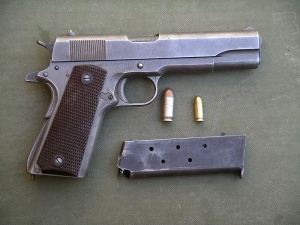
| |
| Mid-1945 produced M1911A1 U.S. Army semi-automatic pistol by Remington Rand. This one was re-built by Anniston Army Depot, October 1972, and carries the ANAD 1072 stamp. The cartridges shown are the .45 ACP (left) and 7.65 mm Browning/.32 ACP (right). Confiscated early 2004 in or around Al-Qurna, Iraq, by Dancon/Irak. Destroyed shortly after. | |
|
| |
| Type | Pistol |
| Land of Origin | United States |
| Specifications | |
| Length | 8.25 in (210 mm) |
| Barrel length | 5.03 in (127 mm), Government model; 4.25 in (108 mm), Commander model; 3.5 in (89 mm), Officer's ACP model |
| Weight | 2.437 lb (1,105 g) empty, w/ magazine (FM 23–35, 1940) |
| Cartridge | .45 ACP |
| Action | Short recoil operation |
|
| |
| Muzzle velocity | 800 ft/s (244 m/s) |
| Effective Range | 75 yd (62 m) (FM 23–35 of 1940) |
| Feed | 7 rounds (standard-capacity magazine), +1 in chamber |
| Service History | |
| In service | 1911-1985 (USA) |
| Used by | United States, United Kingdom, Commonwealth of Nations, (.455 caliber, WWI) |
| Wars | (As official Service pistol) World War I, World War II, Korean War, Vietnam War |
| Production History | |
| Designer | John M. Browning |
| Design Date | 1911 & 1927(A1) |
| No. Built | Over 2 million |
| Variants | M1911A1, RIA Officers |
The M1911 is the most well-known of John Browning's designs to use the short recoil principle in its basic design. Besides the pistol being widely copied itself, this operating system rose to become the pre-eminent type of the 20th century and of nearly all modern centerfire pistols.
Contents |
[edit] History
[edit] Early history and adoption
The M1911 pistol originated in the late 1890s, as a search for a suitable self-loading (or semi-automatic) handgun, to replace the variety of revolvers then in service. The United States of America was adopting new firearms at a phenomenal rate; several new handguns and two all-new service rifles (the M1892/96/98 Krag and M1895 Navy Lee), as well as a series of revolvers by Colt and Smith & Wesson for the Army and Navy were adopted just in that decade. The next decade would see a similar pace, including the adoption of several more revolvers and an intensive search for a self-loading pistol that would culminate in official adoption of the M1911 after the turn of the decade.
Hiram S. Maxim had designed a self-loading pistol in the 1880s, but was preoccupied with machine guns. Nevertheless, the application of his principle of using bullet energy to reload led to several self-loading pistols in the 1890s. The designs caught the attention of various militaries, which began programs to find a suitable one for their forces. In the U.S., such a program would lead to a formal test at the turn of the 19th to the 20th century.
During the end of 1899 and start of 1900, a test of self-loading pistols was conducted, which included entries from Mauser (the C96 "Broomhandle"), Mannlicher (the Steyr Mannlicher M1894), and Colt (the Colt M1900).
This led to a purchase of 1,000 DWM Luger pistols, chambered in 7.65 mm Luger, a bottlenecked cartridge. These would go on field trials but ran into some issues, especially in regard to stopping power. Other governments had also made similar complaints, which resulted in DWM producing an enlarged version of the round, the 9 mm Parabellum (known in current military parlance as the 9x19 mm NATO), a necked-up version of the 7.65 mm round. Fifty of these were tested as well by the U.S. Army in 1903.
In response to problems encountered by American units fighting Moro guerrillas during the Philippine-American War, the then-standard .38 Long Colt revolver was found to be unsuitable for the rigors of jungle warfare, particularly in terms of stopping power, as the Moros had very high battle morale and frequently used drugs to inhibit the sensation of pain. The U.S. Army briefly reverted to using the M1873 single-action revolver in .45 Colt caliber, which had been standard during the last decades of the 19th century; the slower, heavier bullet was found to be more effective against charging tribesmen. The problems with the .38 Long Colt led to the army shipping new single action .45 Colt revolvers to the Philippines in 1902. It also prompted the then-Chief of Ordnance, General William Crozier, to authorize further testing for a new service pistol.
Following the 1904 Thompson-LaGarde pistol round effectiveness tests, Colonel John T. Thompson stated that the new pistol "should not be of less than .45 caliber" and would preferably be semi-automatic in operation. This led to the 1906 trials of pistols from six firearms manufacturing companies (namely, Colt, Bergmann, Deutsche Waffen und Munitionsfabriken (DWM), Savage Arms Company, Knoble, Webley, and White-Merril).
Of the six designs submitted, three were eliminated early on, leaving only the Savage, Colt, and DWM designs chambered in the new .45ACP (Automatic Colt Pistol) cartridge. These three still had issues that needed correction, but only Colt and Savage resubmitted their designs. There is some debate over the reasons for DWM's withdrawal — some say they felt there was bias and that the DWM design was being used primarily as a "whipping boy" for the Savage and Colt pistols,[1] though this does not fit well with the earlier 1900 purchase of the DWM design over the Colt and Steyr entries. In any case, a series of field tests from 1907 to 1911 were held to decide between the Savage and Colt designs. Both designs were improved between each testing over their initial entries, leading up to the final test before adoption.
Among the areas of success for the Colt was a 6,000 round test at the end of 1910 attended by its designer, John Browning. The Colt gun passed with flying colors, having no malfunctions, while the Savage designs had 37.
[edit] Service history
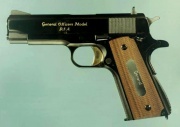
Following its success in trials, the Colt pistol was formally adopted by the Army on March 29, 1911, thus gaining its designation, M1911 (Model of 1911). It was adopted by the Navy and Marine Corps in 1913. Originally manufactured only by Colt, demand for the firearm in World War I saw the expansion of manufacture to the government-owned Springfield Armory.
Battlefield experience in the First World War led to some more small external changes, completed in 1924. The new version received a modified type classification, M1911A1. Changes to the original design were minor and consisted of a shorter trigger, cutouts in the frame behind the trigger, a curved mainspring housing, a longer grip safety spur (to prevent hammer bite), a wider front sight, a shorter spur on the hammer, and simplified grip checkering. Those unfamiliar with the design are often unable to tell the difference between the two versions at a glance. No internal changes were made, and parts remained interchangeable between the two.
[edit] World War II
World War II and the years leading up to it created a great demand for the weapon. During the war, about 1.9 million units were procured by the U.S. Government for all forces, production being undertaken by several manufacturers, including Remington Rand (900,000 produced), Colt (400,000), Ithaca Gun Company (400,000), Union Switch & Signal (50,000), Singer (500), the Springfield Armory and Rock Island Arsenal. So many were produced that, after 1945, the government did not order any new pistols, and simply used existing parts inventories to "arsenal refinish" guns when necessary. This pistol was favored by US military personnel.
Before World War II, a small number of Colts were produced under license at the Norwegian weapon factory Kongsberg Vaapenfabrikk (these Colts were known as "Kongsberg Colt"). During the German occupation of Norway the production continued; these pistols are highly regarded by modern collectors. German forces used captured M1911A1 pistols, using the designation "Pistole 660(a)".[1] The 1911 pattern also formed the basis for the Argentine Ballester-Molina and certain Spanish Star and Llama pistols made after 1922.
[edit] Replacement for most uses
After the Second World War, the M1911 continued to be a mainstay of the United States Armed Forces in the Korean War and the Vietnam War and was even used during Desert Storm in some U.S. Army units.
However, by the late 1970s the M1911A1 was acknowledged to be showing its age. Under political pressure from NATO to conform to the NATO-standard pistol cartridge, the US Air Force's Joint Service Small Arms Program was run to select a new semi-automatic pistol using the NATO-standard 9 mm Parabellum pistol cartridge (a cartridge that had been previously tested by the US Army in 1903 and found wanting). After trials, the Beretta 92S-1 was chosen. This result was contested by the Army which subsequently ran its own competition (the XM9 trials) in 1981 which eventually lead to the official adoption of the Beretta 92F on January 14, 1985. By the later 1980s production was ramping up despite a controversial XM9 retrial and a separate XM10 reconfirmation, which was boycotted by some entrants of the original trials, cracks in the frames of the Beretta-produced pistols, and also despite a dangerous problem with slide separation that resulted in injuries to some US Navy service members. This last resulted in it being updated to the 92FS standard, which includes additional protection for the user.
By the early 1990s, most M1911A1s had been replaced by the M9, though a limited number remain in use by special units. The United States Marine Corps in particular were noted for continuing the use of M1911 pistols for selected personnel in MEU(SOC) and reconnaissance units (though the USMC also purchased over 50,000 M9 handguns). For its part, the United States Special Operations Command (USSOCOM) issued a requirement for a .45 ACP handgun (Offensive Handgun Weapon System (OHWS) trials). This resulted in the Heckler & Koch OHWS becoming the MK23 Mod 0 Offensive Handgun Weapon System (beating a Colt OHWS, a much modified 1911). Dissatisfaction with the Beretta M9's stopping power has actually promoted re-adoption of the 1911 (along with other handguns) among USSOCOM units in recent years, though the M9 remains predominant both within SOCOM and in the US military in general.
[edit] Current users
The M1911A1 design is favored by a large number of police SWAT teams throughout the United States. Many military and law enforcement organizations in the United States and many other countries continue to use (often modified) M1911A1 pistols because they favor the greater stopping power of the .45 cartridge and the superior handling of the weapon in close fighting. Marine Force Recon, Los Angeles Police Department Special Weapons and Tactics, the FBI Hostage Rescue Team and 1st Special Forces Operational Detachment - Delta (Delta Force) are among them. The Tacoma, WA Police Department made history in 2001 by becoming the first metropolitan police department in nearly 50 years to adopt the 1911 as its official carry weapon. The Tacoma Police Department selected the Kimber Pro Carry II or Pro Carry II HD as optional, department supplied weapons available to its officers.[2]
The M1911A1 is also extremely popular among the general public in the United States for practical and recreational purposes. The pistol is commonly used for concealed carry (thanks in part to a single-stack magazine, which makes for a thinner pistol; thus easier to conceal), personal defense, target shooting, and competition. Numerous aftermarket accessories allow users to customize the pistol to their liking. There are a growing number of manufacturers of 1911-type pistols and the model continues to be quite popular for its reliability, simplicity, and nationalist appeal. Various tactical, target, and compact models are available. Price ranges from a low end of $250 for an imported model to more than $3,000 for the best competition or tactical models such as those by Rock River Arms, Springfield Armory, STI International Inc, Strayer Voigt Inc, Kimber Manufacturing, Wilson Combat, and Les Baer.
Due to an increased demand for M1911 pistols among Army Spec Ops units, who are known to field a variety of 1911 pistols, the Army Marksmanship Unit began looking to develop a new generation of M1911s and launched the M1911-A2 project in late 2004. The goal was to produce a minimum of seven variants with various sights, internal and external extractors, flat and arched mainspring housings, integral and add-on magazine wells, a variety of finishes, and other options with the idea of providing the end-user a selection from with to select the features that best fit their missions. The AMU performed a well received demonstration of the first group of pistols to the Marine Corps at Quantico and various Spec Ops units and Ft. Bragg and other locations. The project provided a feasibility study with insight into future projects. Models were loaned to various Spec Ops units, the results of which are classified. An RFP was issued for a Joint Combat Pistol but it was ultimately canceled. Currently units are experimenting with a 1911 platform in .40 which will incorporate lessons learned from the 1911 A2 project. Ultimately, the 1911 A2 project provided a test bed for improving existing 1911s. Perhaps we will see development of an improved 1911 variant in the near future.[3]
The Springfield Custom Professional Model 1911A1 pistol is produced under contract by Springfield Armory for the FBI regional SWAT teams and the Hostage Rescue Team. This pistol is made in batches on a regular basis by the Springfield Custom Shop, and a few examples from most runs are made available for sale to the general public at a selling price of approximately US$2,500 each.
The Rapid Action Battalion (RAB Forces), an anti-terrorist tactical team in Bangladesh uses this gun.
[edit] MEU(SOC) pistol
- Main article: MEU(SOC) pistol
USMC Marine Expeditionary Units continue to issue M1911s to Force Recon units. Hand-selected Colt M1911A1 frames were gutted, deburred, and prepared for additional use by the USMC Precision Weapon Section (PWS) in Quantico, VA. They were then assembled with after-market grip safeties, ambidextrous thumb safeties, triggers, improved high-visibility sights, accurized barrels, grips, and improved Wilson magazines. These hand-made pistols were tuned to specifications and preferences of end users.
In the late 1980s, USMC Colonel Robert Young laid out a series of specifications and improvements to make Browning's design ready for 21st century combat, many of which have been included in MEU(SOC) pistol designs. However, as the U.S. Marine Corps began its process of hand selecting members from its Force Recon to be submitted to USSOCOM as Marine Corps Special Operations Command, Detachment One (MCSOCOM Det-1), the selection of a .45 ACP M1911A1-based pistol meant roughly 150 units would be needed, quickly. The PWS was already backlogged with producing DMRs, USMC SAM-Rs, and updating M40A1s to M40A3s, so Det-1 began the search for COTS (commercial off-the-shelf) surrogates to use. Discovering that the Los Angeles Police Department was pleased with their special Kimber M1911 pistols, a single source request was issued to Kimber for just such a pistol despite the imminent release of their TLE/RLII models. Kimber shortly began producing a limited number of what would be later termed the Interim Close Quarters Battle pistol (ICQB). Maintaining the simple recoil assembly, 5-inch barrel (though using a stainless steel match grade barrel), and internal extractor, the ICQB is not much different from Browning's original design.
The final units as issued to MCSOCOM Det-1 are the Kimber ICQBs with Surefire IMPL (Integrated Military Pistol Light), Dawson Precision Rails, Tritium Novak LoMount sights, Gemtech TRL Tactical Retention Lanyards, modified Safariland 6004 holsters, and Wilson Combat '47D' 8 round magazines. They have reportedly been used with over 15,000 rounds apiece.
[edit] Other users
Numbers of Colt 1911s were used by the Royal Navy as sidearms during World War I in .455 Webley Automatic caliber. The handguns were then transferred to the Royal Air Force where they saw use in limited numbers up until the end of World War II as sidearms for air crew in event of bailing out in enemy territory. Some units of the South Korean Air Force still use these original batches as officers' sidearms(2008).
Norway used the Kongsberg Colt which was a license produced variant and is recognized by the unique slide catch. Argentina manufactured them for some time and led to the cheaper Ballester-Molina. Many Spanish firearms manufacturers produced the M1911 such as the STAR Model P, the ASTAR 1911PL, just to name a few.
The Brazilian company IMBEL (Indústria de Material Bélico do Brasil) still produces the .45 in several variants for military and law enforcement uses.
The Greek Hellenic Army issues the M1911 as a sidearm. These are WWII production American pistols supplied as military aid in 1946 and afterward as the US aided Greece against Communist expansion.[4]
The Royal Thai Army still uses USGI 1911's supplied as military aid during the Vietnam War era.
A Chinese company Norinco exports a clone of the 1911A1 for civilian purchase. Importation into the US was blocked by new trade rules in 1993.
[edit] Design
| How the 1911 works |
|---|
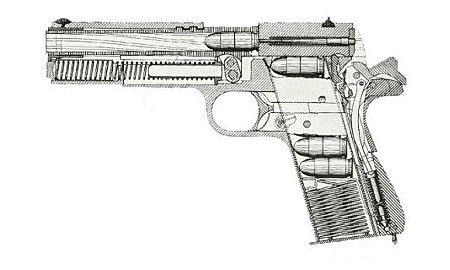
|
Asking for a .45-caliber automatic pistol was a tall order that few manufacturers or inventors attempted successfully in the early 20th century. To accomplish this, Browning settled on a design that is so timeless, it has been changed little in nearly 100 years of production. The basic principle of the pistol is recoil operation. As the expanding combustion gases force the bullet down the barrel, they give reverse momentum to the slide and barrel which are locked together during this portion of the firing cycle. After the bullet has left the barrel, the slide and barrel continue rearward a short distance.
At this point, a link pivots the barrel down, out of locking recesses in the slide, and brings the barrel to a stop. As the slide continues rearward, a claw extractor pulls the spent casing from the firing chamber and an ejector strikes the rear of the case pivoting it out and away from the pistol. The slide stops and is then propelled forward by a spring to strip a fresh cartridge from the magazine and feed it into the firing chamber. At the forward end of its travel, the slide locks into the barrel and is ready to fire again.
The military mandated a grip safety and a manual safety. A grip safety, sear disconnect, slide stop, half cock position, and manual safety (located on the left rear of the frame) are on all standard M1911A1s. Several companies have developed a firing pin block safety. Colt's 80 series uses a trigger operated one and several other manufacturers use a Swartz firing-pin safety, which is operated by the grip safety.
The same basic design has also been offered commercially and has been used by other militaries. In addition to the .45 ACP (Automatic Colt Pistol), models chambered for .38 Super, 9mm Parabellum, .400 Corbon, and other cartridges were also offered. The M1911 was developed from earlier Colt designs firing rounds such as .38 ACP. The design beat out many other contenders during the government's selection period, during the late 1890s and 1900s, up to the pistol's adoption. The M1911 officially replaced a range of revolvers and pistols across branches of the U.S. armed forces, though a number of other designs would see some use in certain niches.
Despite being challenged by newer and lighter weight pistol designs in .45 caliber, such as the Glock 21, the SIGARMS P220 and the aforementioned Heckler & Koch Mk 23, the original 1911 design shows no signs of decreasing popularity. Despite its relatively large size, the M1911 has a very flat profile owing to its single-stack magazine design, easing concealment.
[edit] Specifications
- Cartridge: .45 ACP;
- Other commercial and military derivatives: Other versions offered include .38 Super, 9 mm Parabellum, .40 S&W, 10 mm Auto, .400 Corbon, .22 LR, .50 GI, 9x23 mm Winchester, and others. The major ones were 9 mm Parabellum (9x19 mm), .38 Super, 10 mm Auto.
- Barrel: 5 in (127 mm) Government, 4.25 in (108 mm) Commander, and the 3.5 in (89 mm) Officer's ACP. Some modern "carry" guns have significantly shorter barrels and frames, while others use standard frames and extended slides with 6 in (152 mm) barrels
- Rate of twist: 16 in (406 mm) per turn, or 1:35.5 calibers (.45 ACP)
- Operation: Recoil-operated, closed bolt, single action, semi-automatic
- Weight (unloaded): 2 lb 7 oz (1.1 kg) (government model)
- Height: 5.25 in (133 mm)
- Length: 8.25 in (210 mm)
- Capacity: 7+1 rounds (7 in standard-capacity magazine +1 in firing chamber); 8+1 in aftermarket standard-size magazine; 9+ in extended and hi-cap magazines/frames guns chambered in .38 Super and 9 mm have a 9+1 capacity. Some models using double-stacked magazines, such as those from Para Ordnance, Strayer Voigt Inc and STI International Inc have significantly larger capacities. Colt makes their own 8 round magazines which they include with their Series 80 XSE models.
- Safeties: A grip safety, sear disconnect, slide stop, a half cock position, and manual safety (located on the left rear of the frame) are on all standard M1911(A1)s. Several companies have developed a firing pin block. Colt's 80 series uses a trigger operated one and several other manufacturers (such as Smith & Wesson) use one operated by the grip safety.
- Grip safety deactivation: A problem for some shooters is that they have trouble deactivating the grip safety when they hold the gun. This primarily affects shooters who have small hands. It can also occur when a shooter places his thumb on top of the thumb safety, which tends to reduce pressure on the grip safety. To rectify this problem, a number of grip safety manufacturers have designed safeties with extended ridges, so that when a shooter grips the gun, his hand will come into contact with the ridges and deactivate the safety (i.e., allowing the gun to fire). Some instructors find this "problem" to be a result of poor hand placement, since an 11 year-old was documented able to do so[5], or worn safety components, known to both military[6] and civilian armorers[7] and systematic checks are to be made to verify its functionality.
[edit] Resources
| Gun Owners' Resource has the following relevant documents available for free download for the M1911 Colt pistol and/or its variants: |
The following diagrams are also available:
The AMT Hardballer clone, w/ parts list
[edit] See also
- How to: Function check a 1911
- How to: Safety check a 1911 after disassembly
- Preventing 1911 hammer follow
- Understanding Colt 1911 parts
[edit] Notes
- ↑ Hallock, Kenneth R., Hallock's .45 Auto Handbook, Kenneth R. Hallock, 1980.
- ↑ December 2001 Shooting Industry article
- ↑ Army Marksmanship Unit: The Pipeline for Spec Ops Weapons
- ↑ Greek Military
- ↑ Keep and Bear Arms - Gun Owners Home Page - 2nd Amendment Supporters
- ↑ TM-9-1005-211-34
- ↑ see: How to: Function check a 1911
[edit] References
- U.S. Military Automatic Pistols 1894-1920 by Edward Scott Meadows (Richard Ellis Publications 1993)
- Colt 1911 & Early prototypes by Gerard Henrotin (H&L Publishing - HLebooks.com 2003)
- The Colt 1911A1 Explained by Gerard Henrotin (H&L Publishing - HLebooks.com 2004)
- Early Colt Pistols Models 1900-1902-1903 by Gerard Henrotin (H&L Publishing - HLebooks.com 2008)
[edit] External links
- Colt Manufacturing Company 1911 page
- Official M1911 Safety and Instruction Manual (.pdf)
- Official M1911A1 Safety and Instruction Manual (.pdf)
- Official MKIV Series 70/Model O Safety and Instruction Manual (.pdf)
- Official MKIV Series 70/Model O1970A1 Safety and Instruction Manual (.pdf)
- Official MKIV Series 80/90 Safety and Instruction Manual (.pdf)
- Sam Lisker's Colt Automatic Pistols Home Page
- The M1911 Magazine FAQ
- The Thompson-LaGarde Cadaver Tests of 1904
- Reference manual page with several M1911 manuals on 90th Infantry Division Preservation Group's site
- Articles page including on blank adapting the M1911 on 90th Infantry Division Preservation Group's site
- Colt M1911A1 on ww2db.com
- M1911 Pistols Organization main page, Detailed animated drawing of all operational parts and Syd's 1911 Notebook on M1911.org
| This article is part of a series on the works of John Moses Browning | ||
|---|---|---|
| Semi-automatic pistols | FN M1900 · Colt M1900 · Colt M1902 · FN Model 1903 · M1903 Pocket Hammer · M1903 Pocket Hammerless · M1908 Vest Pocket · FN Model 1910 · M1911 · Colt Woodsman · Baby Browning · Hi-Power | 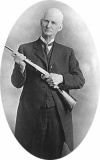 |
| Rifles | Winchester Model 1885 · Winchester Model 1886 · Winchester 1892 · Winchester Model 1894 · Winchester Model 1895 · Remington Model 8 · Remington Model 24 · FN Trombone | |
| Shotguns | Winchester Model 1887 · Winchester Model 1897 · Browning Auto-5/Remington Model 11 · Remington Model 17 · Savage Model 520 · Browning Superposed · Ithaca 37 | |
| Machine guns | Colt-Browning M1895 · Browning M1917 · Browning Automatic Rifle · Browning M1919 · M2 Machine Gun | |
| Cartridges | .25 ACP · .32 ACP · .38 ACP · .380 ACP · .45 ACP · .50 BMG | |


